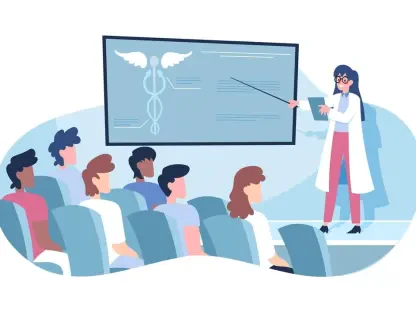Faisal Zain is a renowned healthcare expert specializing in medical technology. With vast experience in manufacturing medical devices used for diagnostics and treatment, he has been on the forefront of driving innovation in the healthcare field. His insights provide valuable context on the integration and efficacy of AI tools in transforming healthcare delivery.
Can you elaborate on the importance of having an enduring, ambitious vision for healthcare organizations when integrating AI tools?
An enduring, ambitious vision is crucial because it sets the direction and the long-term goals for healthcare organizations. It ensures that the integration of AI tools aligns with the strategic objectives and core values of the organization. When leaders are clear about their vision, they can make informed decisions that prioritize sustainable growth and innovation. Without a compelling vision, efforts could become fragmented and fail to drive the transformative change that AI promises.
What kind of trade-offs and investments do leadership and boards need to make to achieve this vision?
Leadership and boards need to balance immediate operational demands with long-term strategic investments. This involves allocating substantial financial resources towards research and development, training staff, and upgrading existing systems to integrate new AI solutions. They also need to make tough decisions, often sacrificing short-term profitability for future benefits. Additionally, fostering a culture of innovation and continuous improvement may require revamping organizational structures and processes.
How can leaders motivate their teams to think beyond the status quo?
Leaders can inspire their teams by clearly communicating the organization’s vision and the role each team member plays in achieving it. Encouraging a culture of curiosity and experimentation allows employees to explore new ideas without fear of failure. Recognizing and rewarding innovative thinking and successful implementations can further motivate teams. Providing ongoing education and training to keep staff updated on technological advances makes them more equipped and confident to adopt new methodologies.
How can healthcare organizations more thoroughly evaluate the effectiveness of AI tools?
Healthcare organizations can establish rigorous evaluation protocols that include pilot studies, performance metrics, and feedback loops. Engaging clinicians in the assessment process ensures that AI tools meet practical needs and provide real-world benefits. Collaborating with technology vendors to customize solutions can also enhance effectiveness. Regularly reviewing the outcomes and comparing them with established benchmarks helps to refine tools and approaches.
What are some specific areas where AI has shown promise in healthcare despite not yet providing significant ROI?
AI has shown considerable promise in areas like predictive analytics for patient outcomes, personalized treatment plans, and automated imaging analysis. These applications can potentially improve accuracy in diagnostics, enhance patient care personalization, and reduce manual workload for clinicians. Although the significant ROI may be pending, these technologies are laying the groundwork for more efficient and effective healthcare delivery in the future.
Can you discuss the reliability concerns associated with AI-enabled tools like digital diabetes management programs and ambient scribes?
Reliability concerns stem from the variability in data quality, algorithm accuracy, and integration with existing healthcare systems. AI-enabled tools like digital diabetes management programs need consistent and high-quality data to provide accurate recommendations. Ambient scribes, which automatically document patient interactions, must ensure precision in capturing medical information. Addressing these concerns requires rigorous testing, continuous improvement, and validation against clinical standards.
What technological solutions are being implemented to improve clinician workflow before patient encounters?
Several technologies are streamlining clinician workflows, such as electronic health record (EHR) systems integrated with AI that prepopulate patient information and suggest possible diagnoses. Virtual assistants can schedule appointments, manage documentation, and handle administrative tasks, freeing clinicians to focus more on patient care. Predictive analytics tools help clinicians prioritize cases based on urgency and patient risk, optimizing workload management.
How is Providence using AI to save time for clinicians and improve the efficiency of patient care?
Providence utilizes AI solutions like Nuance’s DAX Copilot to automate the creation and updating of medical records. This reduces the administrative burden on clinicians and ensures accurate documentation. Additionally, Providence uses technology to prioritize physician emails, filtering urgent communications and allowing physicians to dedicate more time to patient care. These tools collectively enhance workflow efficiency and patient interaction quality.
Can you describe any technology prioritizing physician emails? How effective has it been?
AI-driven tools that prioritize physician emails use machine learning algorithms to filter and rank emails based on their urgency and relevance. By sorting through vast amounts of communication, they ensure that critical messages are addressed promptly while less important ones are queued for later. This helps physicians manage their time more effectively, reduces information overload, and allows them to focus on pressing clinical matters. The effectiveness of such tools hinges on their ability to accurately understand and categorize content, which has shown promising results in initial implementations.
How does the job application process for Amazon drivers differ from applying for nursing jobs in terms of user experience?
Amazon’s job application process for drivers is streamlined and candidate-centric, focusing on simplicity and ease of use. Key features include mobile-friendly applications, quick application completion, and immediate feedback. Conversely, nursing job applications often involve complex, lengthy forms and multiple steps that prioritize the employer’s screening needs over candidate convenience. Simplifying the nursing application process could attract more candidates and reduce barriers to entry, aligning it more closely with the user-friendly approach seen in other industries.
In what ways can healthcare providers improve the job application process to make it more candidate-friendly?
Healthcare providers can enhance the job application process by implementing digital solutions that reduce complexity, such as automated resume parsing, straightforward interface design, and mobile compatibility. Providing real-time feedback and clear communication throughout the application stages can improve the candidate experience. Additionally, streamlining required documentation and background checks, and ensuring swift processing of applications can make the hiring process more efficient and appealing to prospective employees.
What kind of innovation is happening in labor markets within healthcare, particularly regarding hiring practices?
There is significant innovation in healthcare labor markets, focusing on creating more efficient and effective hiring practices. AI and machine learning are being utilized to automate screening and selection processes, reducing human bias and expediting the hiring process. Digital platforms provide better candidate matching based on skills and experience, while virtual job fairs and online onboarding processes streamline recruitment. These innovations enhance the ability to attract and retain qualified personnel in a competitive job market.
How can healthcare employers match the level of innovation seen in care delivery with their hiring processes?
Healthcare employers can adopt advanced technologies like AI-driven recruitment platforms and digital engagement tools to modernize hiring. By leveraging data analytics, they can identify trends and preferences among job seekers, tailoring their recruitment strategies accordingly. Integrating seamless application systems and virtual assessment centers can also align hiring processes with the innovative care delivery models that prioritize efficiency and patient satisfaction.
Why did hospital-at-home programs gain popularity during the COVID-19 pandemic?
Hospital-at-home programs gained traction during the COVID-19 pandemic due to the urgent need to reduce hospital overcrowding and minimize infection risks. These programs allowed patients to receive high-quality care in their homes, leveraging remote monitoring and telehealth technologies. The flexibility and convenience offered by hospital-at-home solutions provided a safer alternative while addressing capacity issues and maintaining continuity of care.
What are the main challenges facing the wider adoption of hospital-at-home programs?
The main challenges include securing sustainable funding, integrating technology with existing healthcare systems, and training staff to manage remote care effectively. Resistance from traditional healthcare models and regulatory barriers also impede broader adoption. Ensuring consistent and reliable patient monitoring, managing logistics, and maintaining high-quality clinical standards remotely are additional hurdles that need addressing.
How can entrepreneurial clinicians help advance hospital-at-home initiatives, and what support do they need?
Entrepreneurial clinicians can drive hospital-at-home initiatives by innovating care protocols and championing the integration of remote monitoring technologies. To succeed, they need support in the form of funding, robust training programs, and strategic partnerships with tech developers. Regulatory flexibility and endorsement from healthcare institutions can also empower clinicians to implement and scale these initiatives effectively.
Why is it imperative for payers and providers to collaborate more effectively?
Effective collaboration between payers and providers is essential for delivering comprehensive, affordable, and high-quality healthcare. Joint efforts help streamline care delivery, ensure patient needs are met holistically, and optimize resource allocation. Collaboration enables the sharing of crucial data, fostering innovation and enhancing patient outcomes. A unified approach can also address broader systemic challenges, reducing inefficiencies and improving access to care.
What tools can payers and providers use together to avoid leaving their populations behind?
Payers and providers can use shared platforms for patient data exchange, predictive analytics for risk assessment, and integrated care management systems. AI-driven tools can amplify these efforts by providing insights into patient populations, helping to identify gaps in care, and coordinating interventions. Collaborative technologies that facilitate real-time communication and decision-making ensure that patients receive timely and coordinated care, preventing disparities.
How does AI facilitate collaboration between payers and providers?
AI facilitates collaboration by generating actionable insights from aggregated data, enabling both payers and providers to address patient needs more effectively. Predictive analytics can forecast patient risks and outcomes, guiding joint strategies for preventive care. Furthermore, AI-driven communication platforms streamline information sharing and decision-making processes, ensuring alignment in care plans and enhancing overall healthcare delivery.
Do you have any advice for our readers?
Stay informed and adaptable in the evolving landscape of healthcare technology. Embrace innovation but prioritize thorough evaluation and practical implementation. Continuous learning and collaboration are key to leveraging tech advancements for better patient care and operational efficiency.









